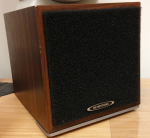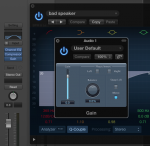 The Behringer Behritone C5A and its updated sibling, the C50A, are copies of the famed Auratone speakers, known for being so bad they’re good. They became staples in music studios after mixing and mastering engineers discovered that if they could get a track to sound good on the little brown cubes, they’d sound good anywhere.
The Behringer Behritone C5A and its updated sibling, the C50A, are copies of the famed Auratone speakers, known for being so bad they’re good. They became staples in music studios after mixing and mastering engineers discovered that if they could get a track to sound good on the little brown cubes, they’d sound good anywhere.
I’d considered picking them up before but it didn’t occur to me that I really only needed one to do the job, until I read Graham Cochrane’s post on them recently on his excellent Recording Revolution website. The combination of this lo-fi speaker and mixing in mono have completely changed the way I mix.
The speaker itself is an active 30W, 5 1/4″ speaker with a 90 Hz to 17 kHz frequency response and retails for about $99US. I was happy and lucky to get mine on ebay for $65 shipped. It has XLR, 1/4″ TRS and RCA input connectors plus a gain control. I am using the 1/4″ connector with a mono > stereo adapter and run through my computer stereo out. The main trick to this speaker is to acclimate your ears by listening to songs you know well on it and hearing the difference from what you think you know. Reference tracks are a must. But mono mixing on this speaker forces you to concentrate on the midrange meat of a song, and can quickly help you to fix overlapping frequencies for better clarity.
 I went a step further and decided to simulate this speaker in the box just for fun, by creating a Logic channel strip preset with the Gain plugin set to mono, the EQ rolled off gradually below 500 Hz and above 2 Khz (a Bob Katz suggestion) and very light (1.5) compression. Running your mix through an optional channel strip like this prior to stereo out will give a good impression of how your mix will sound through a limited range mono speaker.
I went a step further and decided to simulate this speaker in the box just for fun, by creating a Logic channel strip preset with the Gain plugin set to mono, the EQ rolled off gradually below 500 Hz and above 2 Khz (a Bob Katz suggestion) and very light (1.5) compression. Running your mix through an optional channel strip like this prior to stereo out will give a good impression of how your mix will sound through a limited range mono speaker.
The speaker itself? Wonderfully crummy sounding. It’s a game-changer for me and I can already hear my mixes getting better. Definitely worthy of a Pick of the Week.

